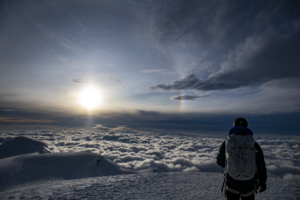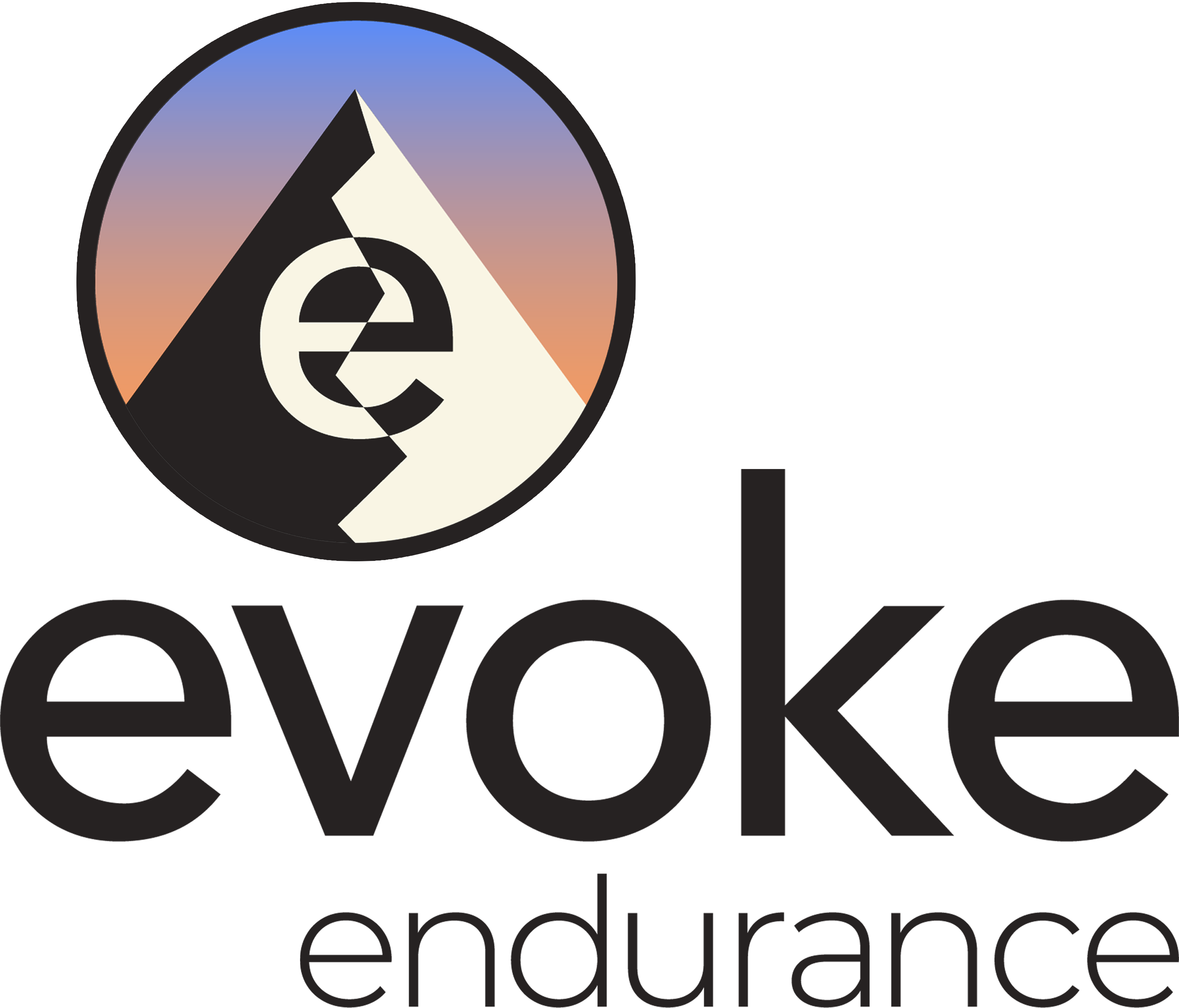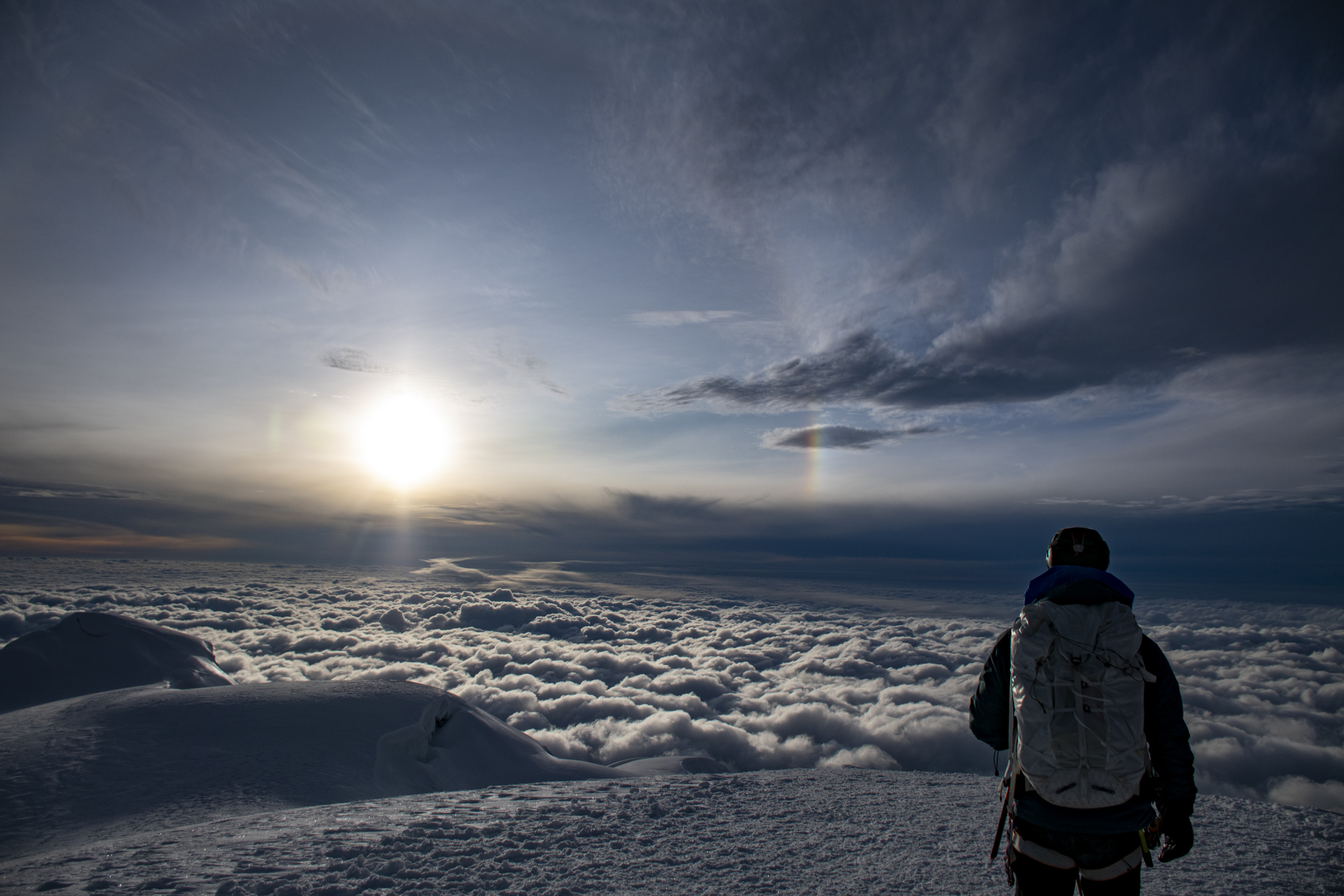By Coach Leif Whittaker and Devin Geoghegan
One of the first things Devin told me when I started coaching him in July 2022 was that he nearly died from high altitude pulmonary edema (HAPE) six months ago during an attempted climb of Cayambe, an 18,996-foot glaciated volcano in Ecuador. He had been so hypoxic as he descended with his guide that he experienced a hallucination about following his two young daughters down from 17,000 feet. He also said he used to work on Wall Street and once took a personality test where he scored 100% for “competitiveness.”
As I got to know Devin, I noticed he was highly committed to training and couldn’t stand seeing an incomplete workout on his calendar. He applied his analytical brain to fitness, regularly unearthing valuable insights from the nuances of his training data. He had a refreshingly down-to-earth and humble perspective on climbing mountains—not what you might first expect from a man at the top of the competitiveness scale.
Devin came into coaching with a strong training history and an excellent understanding of endurance training principles. His Chronic Training Load (CTL) in Training Peaks was in the low 90s when we started working together, and he was regularly training more than 10 hours per week. He had set the goal of returning to Ecuador to climb three major peaks in January 2023. After his close call on Cayambe, he wanted to determine whether climbing big mountains was something he should keep pursuing or if his lungs just weren’t cut out for it.
During his trip, he emailed me dispatches about his experiences. On a personal level, reading his stories was deeply fulfilling for me as a coach, but beyond that, his entertaining, inspiring, and thoughtful writing contained many poignant insights that I think will benefit the Evoke community and outdoor community as a whole. Devin and I worked together to bring his recent training history and correspondence from Ecuador into the form of this article.

photo by Camilo Andraded
The Training Plan
Devin was already muscularly strong when he started coaching. He had been working with a personal trainer twice per week in the gym and also lifting weights on his own. One of our objectives in his training plan was to slim down his upper body and cut some weight without losing too much strength. For the first 11 weeks, he strength-trained three times per week, with a focus on single-leg stability, core strength, max strength for mountaineering-specific movements, and upper body maintenance. When he started the Muscular Endurance phase about 14 weeks prior to his departure, we reduced gym-based strength training to twice per week, with one session focused on core and knee stability and the other on core and upper body maintenance. He also consulted with a nutritionist, dialing in a nutrition plan that provided the macronutrients he needed for hard training. He operated at a minor calorie deficit for several months and then balanced his burn and intake when the Muscular Endurance phase began. These changes, along with an increase in overall aerobic training volume, allowed him to go from 199 pounds (sub-15% body fat) when we started working together to 188 pounds when he left for Ecuador 6 months later.
Devin had a well-developed aerobic base, but he pushed it higher with an increase in aerobic volume in Zone 1 and Zone 2. Running tended to exacerbate a previous lower back injury from 2017 that had required emergency spine surgery, so he did a lot of his aerobic base workouts on an inclined treadmill. He was comfortable at a 20% grade and gradually increased this to 25% and eventually 30%. He used lower grades for Zone 1 workouts and steeper grades for workouts closer to his Aerobic Threshold (AeT). He also went outdoors for longer, weighted efforts on steep trails 1-2 times per week. He frequented a nearby trail called The Manitou Incline, which consists of 2,744 steps that climb over 2,000 vertical feet in less than a mile, with grades as steep as 68%. This was the perfect training ground for Muscular Endurance workouts when he would carry 40-45 lb of water up the Incline.
He supplemented his weekly routine with several longer excursions outdoors, including an ascent of Longs Peak via the Cables Route, an adventure in tough winter conditions to Andrews Glacier, and a triple ascent of The Manitou Incline in a single day. These and other trips not only provided a major training stimulus but also gave him the opportunity to hone his mountaineering techniques, practice rescue skills, re-test himself at higher altitudes, and experiment with layering and fueling systems.
Devin tolerated training very well. He sustained a regular training volume of 14-17 hours per week and around 7-8 hours during recovery (deload) weeks. On average, about 42.5% of his training volume was accomplished in Zone 1 and roughly 38% in Zone 2, with the remainder obviously being in Zone 3 and 4. Toward the middle of the Muscular Endurance phase, Devin began setting personal records indoors and outdoors. While keeping his HR below AeT, he went faster and gained more elevation than he ever had before on the treadmill. He broke his PR on The Manitou Incline several times during training. The guide with whom he climbed Longs Peak and Andrews Glacier complimented his performance regularly.
All this indicated to me that Devin was more than ready for an expedition to Ecuador. I thought he was a lot fitter than he probably needed to be, and I almost felt bad for the guide and teammates who would have to try to keep up with him. But fitness is only one factor in determining success in the mountains. Would the mountains allow him to reach the summit?
Devin departed Colorado on January 5 and spent a few days relaxing in Quito with an old friend before meeting the climbing team. He would be climbing with a friend and guide he trusted, Camilo Andraded. Each referred to the other as mi pana, which means my good friend or companion in Spanish. They would be an independent two-person rope team within a larger group of guides and climbers. While he wanted the flexibility and familiarity of having a personal guide, Devin repeatedly expressed how important it was for him to stay close to the other rope teams in his party, providing added safety to each other. Their first objective was to do several acclimatization hikes near Quito, followed by summit attempts on Antisana, Cayambe, and Chimborazo.
The following dispatches were synthesized from emails, text messages, and TrainingPeaks comments that Devin wrote while on his expedition.
Ecuador Dispatches
By Devin Geoghegan
January 9 – Pasochoa – 13,780 feet
Not sure what happened today, but I was the slowest in the group out of necessity. Huge lung issues out of nowhere. I’m pretty confused. My lungs didn’t want to process oxygen at all. I breathed harder and faster than in any training session, and it hurt. The lungs were fatigued when descending and still hurt despite slower breathing. No fucking idea what happened. Last year, Pasochoa was a piece of cake.
One guy on the team decided to haul ass out of the gate. It had to be Zone 3 and 4, and the bulk of the team followed him. I refused but eventually got dragged in a bit. When I summited 15 minutes behind the team, it was pouring rain, and the guides had to turn us around. I barely had time to drink water. No way I’m so much slower than everyone.
What I don’t get is why breathing was so hard. I don’t have an infection or a cough. Breathing was the worst from 13,000-13,700 feet, toward the top. It was steep and I had to slow down. My lungs prevented my legs from being strong—like I had half a lung. I’m confused because I did Longs Peak in August (higher altitude) and had no issues. I’m rattled and shaken up. I’m worried HAPE left lasting damage. How could it have, given how well training has gone?
Some are passed out on the bus and I’m wide awake with tons of energy. My SpO2 is good and my lungs feel better now. I wasn’t the least bit dizzy or nauseous or anything that would indicate AMS (Acute Mountain Sickness). It’s like my lungs forgot who they were for the day. That climb was a nothing-burger except for the breathing issues.
Note from Coach Leif: I texted and called Devin that evening to reassure him. I felt there was a psychological element at play. I encouraged him to forget about his performance that day and about the other members of the team, especially the guy who was trying to go as fast as possible. I wanted Devin to stop focusing on the analytics, HR, and comparisons to teammates. I wanted him to move freely in the mountains like he knew how to do.
January 10 – Papallacta Hike – 12,910 feet
Once I realized I was mind-fucking myself by linking faster breathing at altitude with rare HAPE and my own anxiety about just being here—let alone climbing here again, given I almost perished last time before my use-by date—I was able to calm down. I’d say my lungs were 90% today versus 65% yesterday, but then panic attacks aren’t helpful for breathing!
I went at my own normal pace today. I didn’t try to gun it or be slow. My pace led nearly the entire way up. I dropped back at one point to rest my lungs because the one-speed demon wouldn’t be quiet for one minute, and I couldn’t take it. Anytime I was in front, he had to zip up and match me—really annoying. I just wanted to focus on myself and nature.
I learned that many of the team members run for training or use treadmills at a 15% grade. They train for speed at lower inclines. We trained for endurance on steep terrain with a lot of weight. Some are sore today. I’m not. A couple now have coughs. I say that not to judge but to sincerely diagnose what happened to me yesterday.
Overall, the team is made up of really good people. All of them asked me about my lungs and checked on me, which I appreciated after yesterday. A caring team is better than the opposite.
My SpO2 is at 94% or better at 11,000 feet. I’m sleeping very well. No headaches. No dizziness. No appetite issues.
January 11 – Antennas Peak – 14,406 feet
Easy. My heart rate was low, and my breathing was slow. I accelerated with ease. I was in the fast group, but my pace was very comfortable. Many have slowed down because of soreness or lung issues. I learned today that one person has a lung infection. I’m full of energy. My SpO2 was at 94% or better at 14,000 feet. I’m climbing my climbs.
We sleep at 9,000 feet tonight before going up to Antisana tomorrow to build camp. I will lose reception until Saturday. I’ll download you then. There has been a lot of rain and snow. It is unclear how bad Antisana is. We will find out.
January 13 – Antisana – 18,875 feet
After two acclimatization trips, we set off at 11:30 pm last night. I had slept great the night before and got 2-3 hours that evening. Meals were large, so I didn’t eat again before departure. On the entire climb, I ate one 200-calorie Power Crunch wafer and got about 500 calories per liter (2 liters total) through Skratch Labs’ super high-carb sport drink mix. That was perfect for me.
We had been rained on profusely every day since arriving in Ecuador, and earlier today, Camilo and I heard avalanches going off on Antisana. I’d been speaking with him about the snow issues for several days. Neither he nor I expected to summit because of the avalanche risk.
I felt like I moved smoothly and efficiently the entire time. My breathing was consistent. It helped keep my HR under control, slow it down after steep sections, and keep any cough at bay. My key request to him was that we stick with our teams for tactical safety. Antisana is heavily crevassed. It proved intense higher up.
The group stopped to take a break together at around 17,000 feet. As Camilo and I approached, I heard the unmistakable loud whumpf of the slab beneath me shifting and settling. If I hadn’t been on Imodium, I’d have shit myself right there!
Camilo did a partial test with another guide, and we could see a slab sitting on complete sugar snow that blew away as you breathed. The sun was beginning to brighten the sky. He and I got very nervous.
The lead guide made the decision to continue up to a safer area. As we climbed higher, we used running belays on very consequential terrain, walking on a knife edge between enormous crevasses. A key snow bridge connecting us to the higher portions was gone. So we all had to be belayed as we jumped over onto a high landing, holding on with ice axes. Check, please!
At about 17,600 feet, the guides conferred and decided to turn us around due to “the slab risk and some teams moving very poorly.” Camilo and I had been moving smoothly the entire time and could have easily gone faster, but I didn’t need to go higher with the avalanche conditions as they were.
We began descending and soon came to the key snow bridge that had broken. The jump down was easier, but we were still belayed across. Camilo and I were fast, but we stopped often to watch our teams behind us. I feel good about quietly but assertively urging us to be safety nets for each other all week. I’m happy I pushed for more snow concern days before we began and that I was present to hear and feel the snow up there. At the bottom, Camilo gave me a big hug and said he felt very safe climbing with me, roped to just me. He said I moved confidently and securely, especially in steep, consequential terrain.
Overall, for me it was healing. I must have repeated the phrase, “I belong here, and I’m home,” dozens of times on that attempt. It was healing because I got back out there and went higher with no breathing or warmth issues at all. It was healing because I conquered my fears about my lungs and just put one foot in front of another. I felt strong and was never tired, never out of energy or the ability to think straight and manage my mind.
I thank you for so much help. Sometimes, perhaps you didn’t know when things you said might have been helping me because it took a while for me to peel the layers.
January 17 – Cayambe – 18,996 feet
Unlike Antisana, I was unable to sleep at all before launching, in no small part due to the insane snoring in the hut’s bunks. We set off just after midnight with Camilo and me in the lead, up approximately 800 feet of Class 1-3 rock. I had no issues whatsoever and was never more than two steps behind. Some didn’t like this part—it’s hard and steppy. The Manitou Incline sent its regards.
We then put on our crampons and ascended the glacier. I had no issues for the next 1,000 feet. The guides didn’t use many switchbacks, so it was fall-line climbing. It felt steeper than Antisana. Around 17,000 feet, the wool buff covering my mouth started causing a lack of airflow. It might have been frozen with breath and spit, but I didn’t realize it until 17,900 feet. My breathing became labored, and my HR felt high, as indicated by lactic acid in the legs, which I hadn’t felt all trip. A few times, I wondered if I would have to turn around yet again, but I focused on one foot in front of another and sucked it up. That 900 feet was, mentally, the toughest part.
At 17,900, the lead guide told me where we were. We had 1,000 feet left. That’s half a Manitou Incline. Let’s fucking go! I took off the buff, and everything returned to normal. Camilo said he felt the rope lighten like the first 2,000 feet. I was able to clear the lactic acid, drop my HR, and breathe.
The last 500 feet was a beast, culminating in what I think was 200-300 feet of 50+ degree climbing. Other than the physicality of suddenly needing all my limbs at that altitude, I had no issues. We popped out to a ledge and traversed a few enormous but easy crevasses and rounded the final part to top out.
Success! Made sweeter by the mountain almost taking my life last year. Camilo and I exchanged enormous hugs, and I fell to the snowy roof in tears and kissed the mountain’s crown. I knew it would be a very emotional climb, one not done for any accolade or bragging rights; rather, a climb for the sole purpose of healing.
I have thought of Ecuador and Cayambe every day for a year. I’ve had panic attacks in cold baths because they triggered the PTSD I was diagnosed with from the trauma of HAPE, hypothermia, and tachycardia. Self-recriminations and feelings of extreme failure have lived rent-free in my head for a year. I kept taking those cold baths and added cold showers to overcome it and train my chest to be okay with being cold again. The weight is still lifting from me. I feel lighter now. A critical chapter in my life has come to an end in the best possible way. It is so freeing.
The internal pressure of the trip has now left me. People are getting really nervous about Chimborazo because it’s even steeper with no flat spots. We have 6-7 hours to climb just under 3,200 feet, meaning a slower pace than Cayambe. Slow and steady.
Thank you for your help and guidance. You have helped me on a journey deeper into myself and into why I climb, and you have helped me to heal.
January 20 – Chimborazo – 20,549 feet
Where to begin? I came to Chimborazo after lifting a year of emotions around Cayambe, so I chose to climb with no expectations and no hopes—only trust in the power of how one foot in front of another would take me on the path I was here to walk.
I’d spent two days eating and resting from Cayambe. While others seemed fussed about the reported steep ascents on Chimborazo, I ignored the guide’s talk and decided it would all be okay.
It has been snowing a lot, and still was on our hike up to base camp at 17,400 feet. The mountain was encased in fog and clouds. We piled into the bubble tents and had dinner. The guides decided to take a shot at midnight despite the snow, given the fantastic conditions otherwise. We would see what the mountain presented.
My SpO2 was at 90% at 17,400 ft. I slept a chunk and woke up spritely. Camilo and I were among the last of 35 people from numerous teams to leave camp. I’m not sure why. There were no major crevasses, so I skinnied down my rack and off we went.
As we climbed, my lungs felt great, and my legs felt strong. This was the best climb yet for me in terms of power, speed, and complete economy of movement. I had zero issues with breathing or HR and no lactic acid in the legs. After a bit, Camilo turned back to me and said, “Shit, you’re strong now that you’re acclimatized.” I told him I felt like a machine.
We reached a steep 20-foot wall. Some turned around here, but I took it in stride. We began passing more people. We took very short breaks because I simply didn’t need them. Soon we had passed all climbers on the entire mountain despite being 30 minutes behind the early starters. We began breaking trail through a foot of new snow. Camilo broke trail, and I deepened it with every step to make a ladder for others. About 150 feet higher, he abruptly stopped and yelled down to me across our short rope that he didn’t like the snow. I knew this was coming.
I dug a pit and identified the same slab risk we saw on Antisana with inches of sugar beneath it. I was able to put my entire arm under the slab. I looked at Camilo and said, “Fuck this.” He agreed, and we radioed to the other groups on the mountain that we felt the avalanche risk was substantial. One group thought we might be overreacting. We just said, “Do what you want, but we are going down because the mountain will always be here for us to climb another time.”
Shortly thereafter, every remaining team had turned around after seeing for themselves what we had found. We descended quickly to a ridge to get off the slab, then Camilo and I did some quick client-to-guide belay-safety practice because it was 3:30 am, and why not? There was no wind; it was a starry night, and what better terrain for training?
Back at the tents, I couldn’t sleep. I was wired and ready to climb again. Even though we didn’t summit, I felt stronger than I ever have. I honestly found it easy. The steepness the guides discussed was there, but it was more about the fall risk to the sides.
This trip is ending, and I feel uplifted and wholly successful. It has solidified for me that it’s the journey, not the summit, that juices me. I’ve found growth every day and am at peace with failed bids. I have learned so much on these climbs. I’m no longer the same person or climber. I have no idea what’s next. I need to enjoy this trip for a bit first. To no longer feel the weight of PTSD is really something.
A final note from Devin: Healing wasn’t possible without many friends. I specifically want to thank my wife, Mei, for being my best friend and supporting me through some very difficult times. Being the spouse of mountaineers is hard. And I want to thank Leif, who helped me in countless ways. As he put it to me one day, “Mountaineering is fundamentally, in my view, not about competition, but about an internal journey of the self, testing ourselves, and overcoming our own fears, weaknesses, and misunderstandings.”




